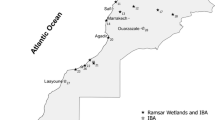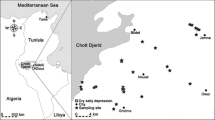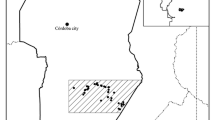Abstract
Conservation of Anatidae in North Africa is hindered by lack of information concerning population size, population trends, and species-habitat relationships. In this work, we used a 2-year survey data in 25 wetlands distributed throughout Morocco to model duck spatial distribution and to assess the relevance of a set of environmental and anthropogenic factors in predicting site occupancy, by means of Generalized Linear Mixed Models (GLMM). Mallards and Ferruginous ducks were the most commonly detected species, whereas White-Headed Ducks and Common Pochards were the least detected ones. An inter-annual variation in site occupancy was recorded for Ruddy Shelducks, Red-Crested Pochards and White-Headed Ducks. Geographical location (measured mainly as distance to the coastline and altitude) was the major predictor of the occurrence probability of Ruddy Shelducks, Marbled Teals and Red-Crested Pochards, while human presence and habitat features were the most relevant factors in shaping Mallard’s distribution. However, none of the considered environmental and anthropogenic factors explained the distribution patterns of the Ferruginous Duck, Common Pochard and Gadwall. The results of this study clearly show that there are still gaps in our knowledge on factors driving wetland occupancy by breeding Anatidae in Morocco. The pursuit of the investigations, while considering other explanatory factors such as water quality (limnological data), diet, predation, and conservation status, is of great importance to more profoundly understand the dynamics of Moroccan duck populations.


Similar content being viewed by others
References
AEFCS (1996) Plan Directeur des Aires Protégées du Maroc. Administration des Eaux et Forêts et de la Conservation des Sols/ BCEOM/SECA/ISR/EPHE. (Unpublished report)
Almaraz P, Amat JA (2004) Multi-annual spatial and numeric dynamics of the White-headed duck (Oxyura leucocephala) in southern Europe: seasonality, density dependence and climatic variability. J Anim Ecol 73:1013–1023
Amat JA (1982) The nesting biology of ducks in the Marismas of the Guadalquivir, south-western Spain. Wildfowl 33:94–104
Arnold TW (2010) Uninformative parameters and model selection using Akaike’s information criterion. J Wildl Manag 74:1175–1178
Atiénzar F, Antón-Pardo M, Armengol X, Barba E (2012) Distribution of the white-headed duck Oxyura leucocephalais affected by environmental factors in a Mediterranean wetland. Zool Study 51:783–792
Bartoń K (2015) MuMIn: multi-model inference. R package version 1.9.13. http://CRAN.R-project.org/package=MuMIn
Bates D, Maechler M, Bolker B, Walker S (2014) lme4: Linear mixed-ef-fects models using Eigen and S4. R package version 1.1–7. Retrieved 21 Oct 2016. http://cran.r-project.org/package=lme4
Benabid A (1982) Bref aperçu sur la zonation altitudinale de la végétation climacique au Maroc. Ecolg Med 8:301–315
Bengtsson D, Avril A, Gunnarsson G, Elmberg J, Söderquist P, Norevik G, Tolf C, Safi K, Fiedler W, Wikelski M, Olsen B, Waldenström J (2014) Movements, Home-Range Size and Habitat Selection of Mallards during Autumn Migration. PLoS One 9(6):e100764. doi:10.1371/journal.pone.0100764
BirdLife International (2012) IUCN red list for birds. http://www.birdlife.org/. Accessed 1 June 2015
BirdLife International (2015) IUCN red list for birds. http://www.birdlife.org/. Accessed 17 Nov 2016
Block WM, Brennan LA (1993) The habitat concept in ornithology: theory and applications. Curr Ornithol 11:35–91
Broyer J, Curtet L (2010) The influence of macrophyte beds on duck breeding in fishponds of the Dombes region, France. Wildfowl 60:136–149
Burgess TM, Webster R (1980) Optimal interpolation and isarithmic mapping of soil properties. I. The semi-variogram and punctual kriging. J Soil Sci 31:315–331
Burnham KP, Anderson DR (2002) Model Selection and Multimodel Inference. Springer, New York
Caithness TA (1982) Gamebird hunting. The Wetland Press, Wellington, p 96
Cambardella CA, Moorman TV, Novak JM, Parkin TB, Karlen DL, Turco RF, Konopka AE (1994) Field-scale variability of soil properties in Central Iowa soils. Soil Sci Soc Am J 58:1501–1511
Cardador L, Carrete M, Mañosa S (2011) Can intensive agricultural landscapes favour some raptor species? The marsh harrier Circus aeruginosus in Northeastern Spain. Anim Conserv 14:382–390
Castro H, Nevado JC, Paracuellos M, López JM (1994) La Malvasía (Oxyura leucocephala) en la provincia de Almería. Evolución poblacional, nidificación y selección de hábitat. Oxyura 7:119–133
Cherkaoui SI, Dakki M, Lahrouz S, Hanane S (2013) Ten-year survey of breeding Anatidae of Lake Sidi Boughaba (North-western Marocco): status, tendencies of change and avenues for future research. Rev d’Écol (Terre Vie) 68:167–180
Cherkaoui SI, Bouajaja A, El Banak A, Lahrouz S, Hanane S (2014) The Black-necked Grebe (Podiceps nigricollis): an expanding species in the Middle Atlas wetlands, Morocco. Wetl Ecol Manag J 22:93–98
Cherkaoui SI, Hanane S, Magri N, EL Agbani MA, Dakki M (2015) Factors influencing species richness of breeding waterbirds in Moroccan IBA and Ramsar wetlands. A macroecological approach. Wetlands 35:913–922
Cherkaoui SI, Magri N, Hanane S (2016) Factors predicting Ramsar site occupancy by threatened waterfowl: the case of the Marbled Teal Marmaronetta angustirostris and Ferruginous Duck Aythya nyroca in Morocco. Ardeola 63:295–309
Cody ML (1985) Habitat selection in birds. Academic Press, Orlando, p 558
Dakki M, Qninba A, El Agbani MA, Benhoussa A, Beaubrun PC (2001) Waders wintering in Morocco: national population estimates, trends and site-assessments. Wader Study Group Bull 96:47–59
Dakki M, El Agbani MA, Qninba A (eds) (2011) Zones humides du Maroc inscrites jusqu’en 2005 sur la liste de la Convention de Ramsar. Travaux Institut Scientifique, Rabat, Série Générale 7: 238
Defos du Rau P, Barbraud C, Mondain-Mon-val JY (2005) Incorporating uncertainty into analyses of red-crested pochard habitat selection. Biol Conserv 125:355–367
Dormann CF (2007) Effects of incorporating spatial autocorrelation into the analysis of species distribution data. Global Ecol Biogeogr 16:129–138
Dray S, Dufour AB (2007) The ade4 package: implementing the duality diagram for ecologists. J Stat Softw 22:1–20
El Agbani MA, Qninba A, Amezian M, Cuzin F, Dakki M (2009) Le peuplement d’oiseaux d’eau du complexe des zones humides de Smir (Nord du Maroc): état actuel, intérêt patrimonial et évolution depuis les quatre dernières décennies. Bull l’Inst Sci 31:103–110
Ficetola GF, Marziali L, Rossaro B, De Bernardi F, Padoa-Schioppa E (2011) Landscape-stream interactions and habitat conservation for amphibians. Ecol Appl 21:1272–1282
Fishpool LDC, Evans MI (2001) Important bird areas in Africa and associated islands: priority sites for conservation. Birdlife International, Cambridge, p 1144
Fox AD, Jonsson JE, Aarvak T, Bregnballe T, Christensen TK, Clausen KK, Clausen P, Dalby L, Holm TE, Pavon-Jordan D, Laursen K, Lehikoinen A, Lorentsen SH, Møller AP, Nordström M, Ost M, Söderquist P, Therkilden OR (2015) Current and potential threats to Nordic duck populations—a horizon scanning exercise. Ann Zool Fenn 52:193–220
García J, Miguelez D, Astiarraga H, Zumalac arregui C (2015) Factors determining the occupation of marsh harrier Circus aeruginosus breeding grounds in a Mediterranean environment. Bird Study 62:331–338
Goovaerts P (1998) Geostatistical tools for characterizing the spatial variability of microbiological and physico-chemical soil properties. Biol Fertil Soils 27:315–334
Green AJ (1998) Habitat selection by the Marbled Teal Marmaronetta angustirostris, Ferruginous Duck Aythya nyroca and other ducks in the Göksu Delta, Turkey in late summer. Rev d’Écol (Terre Vie) 53:225–243
Green AJ, El Hamzaoui M (2000) Diurnal behaviour and habitat use of nonbreeding marbled teal, Marmaronetta angustirostris. Can J Zool 78:2112–2118
Hoffman DJ, Rice CP, Kubiak TJ (1996) PCBs and dioxins in birds. In: Beyer WN, Heinz GH, Redmon-Norwood AW (eds) Environmental contaminants in wildlife—interpreting tissue concentrations. CRC Press, Boca Raton, pp 165–207
Holopainen S, Arzel C, Dessborn L, Elmberg J, Gunnarsson G, Nummi P, Pöysä H, Sjöberg K (2015) Habitat use in ducks breeding in boreal freshwater wetlands: a review. Eur J Wildl Res 61:339–363
Isenmann P, Moali A (2000) Les Oiseaux d’Alge´rie [Birds of Algeria.]. Société d’Étude Ornithologiques de France, Paris
Isenmann P, Gaultier T, El Hili A, Azafzaf H, Dlensi H, Smart M (2005) Oiseaux de Tunisie [Birds of Tunisia.]. SEOF Editions, Paris
Keddy PA (2010) Wetland ecology—principles and conservation. Cambridge University Press, Cambridge
Khaffou M, Chahlaoui A (2012) La Reproduction du Tadorne Casarca Tadorna ferruginea dans la Zone Humide d’Aguelmam Sidi Ali Moyen Atlas Maroc, vol 4. No 120903, Science Lib Edition Mersenne, p 14
Korschgen CE, Dahlgren RB (1992) Human disturbances of waterfowl: causes, effects, and management. Fish Wildl Leafl 13(2):15
Lahrouz S, Dakki M, Gmira N (2012) The importance of Fouwarate marshland for wintering and breeding of the threatened ducks populations in Morocco. J Anim Plant Sci 13:1800–1810
Lant CL, Kraft E, Beaulieu J, Bennett D, Loftus T, Nicklow J (2005) Using GIS-based ecological–economic modeling to evaluate policies affecting agricultural watersheds. Ecol Eco 55:467–484
Lecis R, Norris K (2004) Habitat correlates of distribution and local population decline of the endemic Sardinian newt Euproctus platycephalus. Biol Conserv 115:303–317
Legendre P, Legendre L (1998) Numerical ecology, 2nd edn. Elsevier, Amsterdam
Liang J, Hua S, Zeng G, Yuan Y, Lai X, Li X, Li F, Wu H, Huang L, Yu X (2015) Application of weight method based on canonical correspondence analysis for assessment of Anatidae habitat suitability: a case study in East Dongting Lake, Middle China. Ecol Eng 77:119–126
M’Hirit O (1999) Climats et bioclimats de la forêt. Le grand livre de la forêt marocaine. Mardaga, Liège, pp 54–60
Ma ZJ, Li B, Zhao B, Jing K, Tang SM, Chen JK (2004) Are artificial wetlands good alternatives to natural wetlands for waterbirds? A case study on Chongming Island, China. Biodivers Conserv 13:333–350
Magin C (2001) Morocco. In: Fishpool LDC and Evans MI (eds) Important bird areas in Africa and associated islands: priority sites for conservation. Pisces Publications and Birdlife International (BirdLife Conservation Series n 11), Newbury
Marone L, Lopez De Casenave J, Cueto VR (1997) Patterns of habitat selection by wintering and breeding granivorous birds in the central Monte desert, Argentina. Rev Chil Hist Nat 70:73–81
Martin TE (1993) Nest predation and nest sites. Bioscience 43:523–532
Mcgarigal K, Cishman SA, Stafford S (2000) Multivariate statistics for wildlife and ecology research. Springer Verlag, New York
McKinney RA, Raposa KB, Cournoyer RM (2011) Wetlands as habitat in urbanizing landscapes: patterns of bird abundance and occupancy. Landsc Urban Plan 100:144–152
Merendino MT, Ankney CD (1994) Habitat use by mallards and American black ducks breeding in central Ontario. Condor 96:411–421
Monfils MJ, Prince HH (2009) Breeding bird response to long-term wastewater discharge in a northern Michigan peatland. Ecol Eng 35:1357–1365
Nakagawa S, Schielzeth H (2013) A general and simple method for obtaining R^2 from generalized linear mixed-effects models. Methods Ecol Evol 4:133–142
Newbold T, Hudson LN, Hill SLL, Contu S, Lysenko I, Senior RA, Börger L, Bennett DJ, Choimes A, Collen B, Day J, De Palma A, Diaz S, Echeverria-Londoño S, Edgar MJ, Feldman A, Garon M, Harrison MLK, Alhusseini T, Ingram DJ, Itescu Y, Kattge J, Kemp V, Kirkpatrick L, KLeyer M, , , , Correia DLP, Martin CD, Meiri S, Novosolov M, Pan Y, Phillips HRP, Purves DW, Robinson A, Simpson J, Tuck SL, Weiher E, White HJ, Ewers RM, Mace GM, Scharlemann JPW, Purvis A (2015) Global effects of land use on local terrestrial biodiversity. Nature 520:45–50
Newton I (1998) Population Limitation in Birds. Academic Press, San Diego
Newton I, Campbell CRG (1975) Breeding of ducks at Loch Leven, Kinross. Wildfowl 26:83–102
Noordhuis R, Van der Molen DT, Van den Berg MS (2002) Response of herbivorous water-birds to the return of Chara in Lake Veluwemeer, The Netherlands. Aquat Bot 72:349–367
Ooi JLS, Van Niel KP, Kendrick GA, Holmes KW (2014) Spatial structure of seagrass suggests that size-dependent plant traits have a strong influence on the distribution and maintenance of tropical multispecies Meadows. PLoS One 9(1):e86782
Pebesma EJ (2006) The gstat package. www.gstat.org
Penteriani V, Gallardo M, Roche P (2002) Landscape structure and food supply affect eagle owl (Bubo bubo) density and breeding performance: a case of intra-population heterogeneity. J Zool 257:365–372
Petit S, Hayson K, Pywell R, Warman L, Allen D, Booth R, Firbank L (2003) Habitat-based models for predicting the occurrence of ground-beetles in arable landscapes: two alternative approaches. Agric Ecosyst Environ 95:19–28
Pöysä H (2001) Dynamics of habitat distribution in breeding mallards: assessing the applicability of current habitat selection models. Oikos 94:365–373
Pöysä H, Elmberg J, Nummi P, Sjöberg K (1996) Are ecomorphological associations among dabbling ducks consistent at different spatial scales? Oikos 76:608–612
Qninba A, Rguibi Idrissi H, Himmi O, Benhoussa A, El Agbani MA, Thévenot M (2008) Nouveaux cas de nidification d’oiseaux dans le complexe de zones humides du Bas Loukkos (Nord-Ouest du Maroc). Bull Inst Sci 30:45–50
Ramsar (2015) Ramsar website, Available at: [http://www.ramsar.org/cda/en/ramsar-about-history/main/ramsar/1-36-62_4000_0__]. Accessed 03 Nov 2016
Ramsar Convention Bureau (2002) What is the Ramsar convention on wetlands?. Ramsar Convention Bureau, Gland
Reich RM, Joy SM, Reynolds RT (2004) Predicting the location of goshawk nests: modeling the spatial dependency between nest locations and forest structure. Ecol Model 176:109–133
Rotella JJ, Ratti JT (1992) Mallard brood survival and wetland habitat conditions in southwestern Manitoba. J Wild Manag 56:499–507
R Development Core Team (2013) R: a language and environment for statistical computing. ISBN 3-900051-07-0, R Foundation for Statistical Computing, Vienna. http://www.R-project.org
Sánchez-Zapata JA, Anadón JD, Carrete M, Giménez A, Navarro J, Villacorta C, Botella F (2005) Breeding waterbirds in relation to artificial pond attributes: implications for the design of irrigation facilities. Biodivers Conserv 14:1627–1639
Sebastián-González E, Fuentes C, Ferrández M, Echevarrías JL, Green AJ (2013) Habitat selection of marbled teal and white-headed duck during the breeding and wintering seasons in south–eastern Spain. Bird Conserv Int 23:344–359
Thévenot M, Vernon R, Bergier P (2003) The birds of Morocco. British Ornithologists’Union/British Ornithologists’Club, Tring
Thorpe J (1997) The implications of recent serious bird strike accidents and multiple engine ingestions. Bird Strike Committee, Boston
Tucker GM, Evans MI (1997) Habitats for birds in Europe: a conservation strategy for the wider environment. BirdLife International BirdLife Conservation Series No. 6), Cambridge
Venables WN, Ripley BD (2002) Modern applied statistics with S, 2nd edn. Springer, New York
Verner J, Morrison ML, Ralph CJ (eds) (1986) Wildlife 2000: modeling habitat relationships of terrestrial vertebrates. University of Wisconsin Press, Madison
Wassens S, Hall A, Osborne W, Watts RJ (2010) Habitat characteristics predict occupancy patterns of the endangered amphibian Litoria raniformis in flow-regulated flood plain wetlands. Austral Ecol 35:944–955
Weller MW (1999) Wetland birds. Habitat resources and conservation implications. Cambridge University Press, Cambridge, p 271
Acknowledgements
We are grateful to N. Magri for helpful in realizing the map. We also thank two anonymous reviewers and the Editor of Ecological Research for their comments and advice.
Author information
Authors and Affiliations
Corresponding author
About this article
Cite this article
Cherkaoui, S.I., Selmi, S. & Hanane, S. Ecological factors affecting wetland occupancy by breeding Anatidae in the southwestern mediterranean. Ecol Res 32, 259–269 (2017). https://doi.org/10.1007/s11284-017-1436-5
Received:
Accepted:
Published:
Issue Date:
DOI: https://doi.org/10.1007/s11284-017-1436-5




